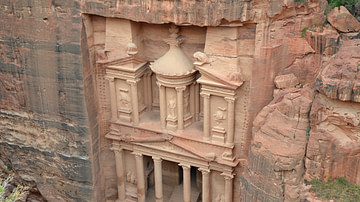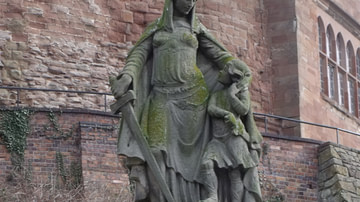Search Images
Browse Content (p. 1149)

Image
Statue of Tigranes the Great
Statue of Armenian king Tigranes the Great (r. c. 95 - c. 56 BCE), on the Republic of Armenia Presidential Palace grounds. Sculptor: Levon Tokmajyan

Image
Tigranes the Great Coin
Obverse of coin depicting Tigranes the Great (r. c. 95 - c. 56 BCE). Minted at Antiochia ad Orontem, near present-day Antakya, Turkey. Silver, weighing approximately 16.5 grams. Acquired 1824 CE. (British Museum, London)

Image
Volubilis
Overview of the ruins of Volubilis located in the middle of a fertile plain about 33km north of Meknès in northern Morocco, near the heights of the Atlas Mountains. Volubilis developed from the 3rd century CE onwards and became an important...

Image
The Civil Basilica of Volubilis
The civil basilica (court of law and seat of the magistrates) lies on the eastern side of the forum of Volubilis (Morocco) and was built during the Severan dynasty between 193 and 235 CE. This imposing building is 42.2m long and 22.3m wide...

Image
The Oval Forum and Cardo Maximus of Gerasa
The Oval Plaza of Gerasa (Jerash, Jordan), built in the beginning of the 2nd century CE to connect the Cardo Maximus with the Sanctuary of Zeus. The colonnades were of Ionic order, with the pillars standing on low blocks.

Image
The Treasury of Petra From Above
The so-called Treasury (Khazneh) in Petra, Jordan. The Treasury's rock-cut, two-storied façade is 24.9 m wide and almost 40 m high and strongly embodies the Hellenistic style and reflects the influence of Alexandria. Both stories are embellished...

Image
Ambrosian Iliad
Picture 47 of the Ambrosian Iliad - an illuminated manuscript of Homer's work dating to the 5th century CE) - showing Achilles making a sacrifice to Zeus in order to ensure Patroclus' safe return (from the Iliad book 16, 220-252).

Image
Monk Working in Scriptorium
Depiction of a monk at work copying a text by hand in a writing room known as a scriptorium. From the 5th to the 13th century CE monasteries were the sole producers of books. The scriptorium was a large room with wooden chairs and writing...

Image
Les Très Riches Heures
Page showing the month of January in the Book of Hours known as Les Très Riches Heures du Duc de Berry (created c. 1412-1416 and 1485-1489 CE). It is frequently referred to as the “king of illuminated manuscripts” because of the grandeur...

Image
Statue of Aethelflaed
Statue of Aethelflaed, Lady of the Mercians (r. 911-918) at Tamworth Castle in Staffordshire, Great Britain. Aethelflaed fortified Tamworth with the construction of an earthen burh in 913, and it was also the place of her death in 918. The...